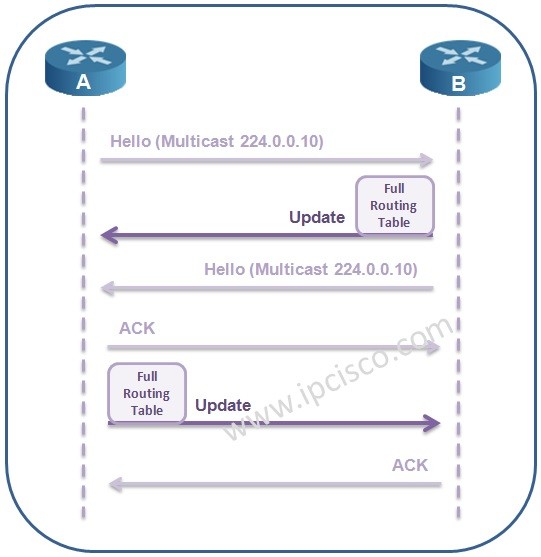- COURSES
- SPECIALS
- BLOG
- MEMBERS
- SHOP
- ABOUT
- ENROLL HERE

Table of Contents
EIGRP Protocol is one of the most used Dynamic Routing Protocol as IGP (Interior Gateway Protocol). Especially it is used for Routing purpose inside the networks that is mostly consist of Cisco devices.
EIGRP (Enhanced Interior Gateway Routing Protocol) is a Hybrid Routing Protocol that show both Distance Vector and Link-State Routing Protocol properties. It was developed by Cisco as an enhancement to IGRP (Interior Gateway Routing Protocol) and as a Cisco proprietary protocol and it is only available on Cisco devices.
You can test your Routing Knowledge on CCNP ENCOR Practice Tests Page!
EIGRP uses DUAL (Diffusing Update Algorithm) for routing calculations. Periodic Updates are not used but if a change occurs in the network like up/down links, update messages are sent.
With DUAL Algotirhm, Topology table is built. In Topology Table both the Best Routes and the Backup Routes to a destination are stored. This provides, a Fast Convergence characteristic, a Fast Convergence Mechanims.
The most important characteristic of this routing protocol is that, it is a Fast Converged Routing Protocol. Enhanced Interior Gateway Routing Protocol keeps the “Backup Routes” beside the “Best Route” to a destination in the Topology table. So, during a failure, it does not need to calculate a new route. Instead, it uses the Backup Route towards the destination.
EIGRP uses different types of messages to build neighbourship, to keep the connection and for the updates. These main messages are :
Hello Packets are used to establish and maintain EIGRP Neighbourship.
Update Packets are used to send routing updates.
Query Packets are used to ask for any routing update, requests an update.
Reply Packets are used as a response to the Query Packets.
ACK Packets are used as a feedback to the Update, Query or Reply packets as a feedback mechanism.
We will learn these EIGRP Packets detailly in next lessons.
Enhanced Interior Gateway Routing Protocol has three tables. These tables are used on Routing Operation. The EIGRP Tables are given below:
Neighbor Table is the table that keeps All EIGRP Neighbour Routers.
Topology Table is the table that keeps All Routes to all the destinations
Routing Table is the table that keeps the Best Routes to any destinations.
Enhanced Interior Gateway Routing Protocol is a Classless Routing Protocol. It sends the subnet masks in the Update Packets.
Enhanced Interior Gateway Routing Protocol also supports VLSM (Variable Length Subnet Mask). Different Subnet Masks can be used with this protocol. By using VLSM, it is a protocol that uses the IP addresses range very efficent.
Enhanced Interior Gateway Routing Protocol uses a very complex metric by using bandwith, delay, load, reliability and MTU values. This EIGRP Metric Formula is showed below:

As you can see, there are some K values in EGRP metric formule. By default these values are:
K1 (Bandwidth) = 1
K2 (Load) = 0
K3 (Delay) = 1
K4(Reliability) = 0
K5(MTU) = 0
These K values need to be match in both ends to form an EIGRP Neighbourship. You can change these values but it is not recommended.
By default Bandwith and Delay values become important only and used as a metric (The other parts will be 0, becaue of multiplying with 0). So, we can say that, Enhanced Interior Gateway Routing Protocol uses the path with minimum bandwidth and the total delay to a destination.
Bandwidth = 107/Bandwidth in Kbps
Delay = Delay / 10
The default Formula becomes like below (with default K values ) :
You can test your Routing Knowledge on CCNP ENCOR Practice Tests Page!

Enhanced Interior Gateway Routing Protocol works with IPv4, IPv6, IPX and AppleTalk Routed Protocols. So with this characteristic, we can say that EIGRP is a Protocol Independent Routing Protocol.
The Administrative Distance (Preference) values for EIGRP are given below:
If there are routes to a destination with Enhanced Interior Gateway Routing Protocol, RIP and OSPF, EIGRP (Internal) Routes are prefered over RIP and OSPF Routes. Because the administartive distance of RIP is 120 and OSPF Administrative Distance is 110.
You can find Administrative Distance (Preference) Table for Cisco, Juniper, Nokia and Huawei, on IPCisco.com.
Enhanced Interior Gateway Routing Protocol uses RTP (Reliable Transport Protocol) to control sending and acknowledging messages. In other words, RTP ensures delivery of packets. RTP is used by Update, Query and Reply packets. Hello and Ack packets do not use RTP.
Leave a Reply